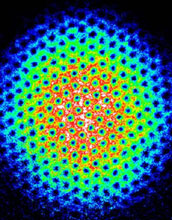Multimedia Gallery
Big Vortex Lattice
Big Vortex Lattice
When a Bose-Einstein condensate (BEC) is set into rapid rotation, vortices enter the condensate and arrange themselves into a regular lattice (Abrikosov lattice). In this false-color image, taken along the axis of rotation, each dark spot within the condensate corresponds to the atom-free core of an individual vortex. The hexagonal arrangement of the vortices is clearly visible. The appearance of these vortices is a consequence of the superfluid nature of a BEC.
This work was supported in part by a grant from the National Science Foundation. (Date of Image: unknown) [One of three related images. See Next Image.]
More about this Image
A BEC is a fascinating object that allows researchers to study the fundamental laws of quantum mechanics. The quantum mechanical nature of a BEC can lead to very unusual phenomena. A particularly striking consequence is that a BEC cannot rotate like a classical liquid. Instead, when a BEC is subjected to fast rotation, vortices appear in the condensate. A vortex resembles an eddy current: it is a filament with a core that is free of atoms, and around this core there is a circular fluid flow.
Researchers in the group of professor Eric Cornell at JILA (a joint institute of the University of Colorado at Boulder and NIST, the National Institute of Standards and Technology) have succeeded in nucleating up to 300 vortices in an individual condensate and are studying their dynamics. These vortex lattices are a striking demonstration for the laws of quantum mechanics that govern a BEC. The importance of this work, however, goes far beyond a mere demonstration of quantum mechanics. BECs have become well-controlled model systems for many areas of physics, reaching from atomic physics to quantum optics and condensed matter physics. Vortex physics is an important example -- in superfluid helium vortices lead to superfluid turbulence, and in type II superconductors vortices exist in the form of magnetic fluxlines. By studying the phenomenon of vorticity that is common to different supersystems, researchers have a unique opportunity to gain inside into the fundamental laws of nature.
Credit: Peter Engels, JILA
Images and other media in the National Science Foundation Multimedia Gallery are available for use in print and electronic material by NSF employees, members of the media, university staff, teachers and the general public. All media in the gallery are intended for personal, educational and nonprofit/non-commercial use only.
Images credited to the National Science Foundation, a federal agency, are in the public domain. The images were created by employees of the United States Government as part of their official duties or prepared by contractors as "works for hire" for NSF. You may freely use NSF-credited images and, at your discretion, credit NSF with a "Courtesy: National Science Foundation" notation.
Additional information about general usage can be found in Conditions.
Also Available:
Download the high-resolution JPG version of the image. (280 KB)
Use your mouse to right-click (Mac users may need to Ctrl-click) the link above and choose the option that will save the file or target to your computer.



